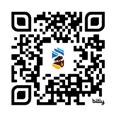manitoba School Counsellor
FALL 2024

The power of trauma-informed schools
The importance of career counselling before post-secondary education
How Pembina Trails School Division and Louis Riel School Division are fostering inclusion



FALL 2024

The power of trauma-informed schools
The importance of career counselling before post-secondary education
How Pembina Trails School Division and Louis Riel School Division are fostering inclusion


BY MICHELLE MORRISON-HEMERYCK, STUDENT SERVICES TEACHER, COLLÈGE JEANNE-SAUVÉ

Each school and school division decides how student services teachers and school counsellors should offer support for their students as they prepare for their postsecondary education. The support offered varies and depends on the students’ interests and the expertise of the student services team. This support often includes meetings and presentations with counsellors from postsecondary institutions or school psychologists and social workers, depending on the youth’s needs.
Career counselling can start as early as Grade 9 using a computer program, such as myBlueprint or Xello, which allow students to explore different career paths complete with approximate salaries and a description of the educational path to follow for the career in question. This helps guarantee the students have the necessary credits to set them up for success in their chosen domain.
Discussions with students and caregivers in Grade 9 can also help counsellors determine whether a student is planning to attend university or one of the many excellent trades and technology institutions throughout the province. These conversations are essential because students can complete their high school credits and receive a trades diploma simultaneously in some programs.
At the beginning of semester two in Grade 10, schools usually invite various institutions to present to their students to help them make educated choices about what path best suits them. Then, in the spring of a student’s Grade 10 year, they must submit their application for institutions such as the Manitoba Institute of Trades and Technology (MITT) and the Louis Riel Arts and Technology Centre (ATC) if they would like to complete their trade by the end of Grade 12.
Individual schools and school divisions will often host career fairs with presentations from various postsecondary institutions for each grade level. There, students will be able to ask questions, pick up a brochure, or connect with current or former students to learn more about post-secondary life. School counsellors can also arrange for group tours of local universities, if there is enough student interest.
Once students reach Grade 11 and 12, the student services team will usually revise any support plans, such as IEPs and Curriculum Modification Plans, to ensure any assessments needed be completed either by school psychologists or by external agencies are done, allowing students to get support at the post-secondary level. These assessments can help caregivers and students advocate for accessibility services at their chosen post-secondary institution. Students with exceptional needs will also be connected to various government organizations, such as Employability Assistance for People with Disabilities (EAPD) or Community Living disABILITY Services (CLDS), to enable continuity of support after high school.
Students can take many different avenues for their future. It requires a team effort to gather as much information as possible and provide it to parents and students, which allows them to make an informed decision on their path after high school. Depending on each youth’s needs, many professionals are often involved in this process. Communication between youth, their caregivers, and the student services team allows for the best possible transition from high school to post-secondary life. l

The job force is continually changing as it ebbs and flows with new positions, talent, and ways to work, on top of the endless daily shifts across the world. Sure, student-dominated industries like hospitality or retail are always an option for your next job, but they aren’t the only ones. There’s a demand for insurance brokers and young professionals in Manitoba, and the insurance industry has plenty of options to help you find the right
career path to fit your goals.
Different types of insurance jobs range from:
• Sales
• Customer Service
• Processing
• Management/Human Resources
• Tech
Along with the many job options, insurance covers a wide range of
topics and skillsets – not just numbers and math. The numbers side is important, but Manitoba insurance is also filled with small business entrepreneurs, and values individuals with great people skills and drive who are eager to advance with the industry.
Much like Manitoba, the insurance industry is consistent yet constantly growing.
Regardless of whether you’re looking for a part-time job while you finish high school, your undergrad, or while seeking a new work opportunity that’s stable and flexible with tons of room to grow, insurance offers different positions for varying experience and personality types.
Becoming a broker only requires taking one course to get started and allows you to move at your own pace.
The insurance industry is seeing a lot of change in the ways people work and how they land their dream job. Experience is important, but so is being a go-getter with a willingness to learn. A lot of brokerages are looking for someone who is the right fit. Brokerages are committed to finding the right people to hire and training them accordingly.
The focus on finding the right people means a post-secondary education is not necessary to become an insurance broker. In fact, many
choose to start the insurance broker education career path instead.
The insurance industry is more than a single position. In one office alone, you could earn different job titles, with plenty of different career paths to choose from, and even more predicted to start in the future.
Some common insurance jobs include:
• Sales – This broad position includes selling anything a broker can offer. If you’re interested in making commission, this is the role for you.
• Customer Service – This frontline job typically involves working with walk-in clients looking to pay for things like their driver’s license.
• Processing – This job is perfect for the introverted types and typically involves working behind the scenes in data entry.
• Management/Human Resources
– Like any other type of industry,
insurance has management and human resources teams to lead and support other insurance brokers.
• Tech – This fun and changing career can involve anything from coding to social media marketing. This job is great for analytical and creative types.
Winnipeg is now seen as a business hub thanks to growth and incoming businesses. The insurance industry is no different, and brokerages are trying to keep up with the growth. Brokerages always need more staff to continue propelling the city and province forward.
Insurance brokers are looking for employees in real time; there are new full and part time positions available weekly. To see what jobs are currently available in the insurance industry, check out our Industry Jobs page on the IBAM website: www.IBAM.mb.ca. l




Maulene Ragat works at HERD North America, a manufacturer of semi-truck accessories company. Maulene is a member of the Canadian Manufacturers and Exporters (CME) Young Adults in Manufacturing Committee and previously received the CME scholarship. This conversation was on August 29th, 2024, and was edited for length and clarity. For the complete interview transcript, visit www.cme-mec.ca/youth/.
Mitchell DeFehr (MD): Could you tell us about Herd before we begin?
Maulene Ragat (MR): HERD North America is a manufacturing company founded in 2003. We started by building bumpers for semi trucks,
and the product line expanded. We have four distinct product lines: aluminum truck guards, stainless steel grille guards, cab guards, and truck accessories. We are a one-stop shop for drivers who want to get from point A to point B safely and have everything they need. HERD’s goal is to improve the lives of our employees and customers – which is why we are also in the process of transforming our original product lines and using more modern manufacturing methods.
MD: Can you describe your current role and responsibilities in manufacturing?
MR: Recently, it changed. My career started in logistics at HERD. Then, I switched to the supply chain, where I did purchasing and procurement. Now it’s getting the team organized for the day, the week, whatever it is, helping people out, see where my teammates are facing challenges and support them wherever possible. Our team’s goal is to ensure that we have everything we need at the right place and at the right time to produce the orders for our customers in a timely manner. I primarily coordinate the
team now.
MD: What are logistics and procurement for people who don’t know?
MR: Logistics is the movement of goods. The transportation could be by land, air, rail, or any movement required for this product to get to wherever it needs to go. That is mainly related to finished goods on our end. But parts from overseas or a different part of the country could fall under that umbrella, but also part of procurement due to the planning requirements. Procurement is the strategic version of day-to-day purchasing and coordinating with the rest of the team, which involves a lot more preparation.
MD: Did you have any doubts or hesitations about entering manufacturing, and how did you overcome those if you did have any?
MR: I never hesitated to go into manufacturing because, at first, I didn’t even know about manufacturing. I kind of do whatever it is that I want to do. I didn’t know about the industry or anything like that. Maybe there was pressure coming from family members because I came
from an Asian background and they have an expectation about pursuing certain careers. Me not following that, of course, they were confused about why I didn’t. But at the same time, I’ve always wanted to try new things which probably helped with acceptance.
MD: Do you have any advice you want to impart before we wrap things up?
MR: For the younger folks here who might be reading, I didn’t know exactly what I wanted to do when I was younger and in school. I thought I was going to get into nursing. I thought I was going to get into education. I thought I would get into a different career mostly because of what I was exposed to when I was younger, but it didn’t happen.
It’s okay not to know what you will do after school. There’s time to think about it. When you get into something that doesn’t end up being what you want and don’t enjoy it, it’s okay to move and try something new that you might not have expected.
I thought I was going to get into a stereotypically very feminine career. This field I’m in is male dominated today, and I’m enjoying what I’m doing. Don’t let gender stereotypes get to you; try things out, see what you enjoy the most, and see if there’s anything to it. If you like buying stuff or shopping, well, purchasing is shopping. You can be a personal shopper for a company; allow yourself to explore. Explore your options and then find what you like, and hopefully you can make a career out of it. So, peace. I think that’s it. That’s all I got. l



In a world that is rapidly evolving due to technological advancements, the significance of skilled trades like masonry often gets overshadowed. However, the Manitoba Masonry Contractors Association (MMCA) believes that now, more than ever, the importance of passing down knowledge and craftsmanship in learning a trade is essential to building a strong future for both individuals and communities.
The journey to becoming a mason is much more than acquiring technical skills. It involves embracing a rich tradition of craftsmanship, dedication, and a strong sense of responsibility to pass these skills to the next generation. For school counsellors, understanding this dynamic can be crucial in guiding students who are exploring career paths in skilled trades. Trades like masonry not only offer viable career options but also

present opportunities to be part of something timeless and deeply rewarding.
Masonry is an ancient craft that combines artistry with engineering. The work of a mason shapes the physical and cultural landscape, from the sturdy walls of schools and hospitals to the intricate designs on historical monuments. But beyond the bricks, stones, and mortar lies an equally important foundation: the tradition of mentorship and handson learning passed down from one generation of masons to the next.
For aspiring masons, learning this trade is not just about memorizing measurements or mastering specific techniques – it’s about developing a keen eye for detail, understanding the importance of structural integrity, and honing the creativity that transforms functional buildings into beautiful
works of art. This knowledge cannot be gleaned from textbooks alone; it requires the kind of real-world, practical experience that only seasoned masons can provide.
One of the key aspects that distinguishes the trade of masonry from other professions is the apprenticeship model of education. Apprenticeships allow experienced masons to pass on their knowledge, wisdom, and craftsmanship directly to the next generation. Through this hands-on learning process, young masons acquire not only the technical skills necessary for their trade but also the values and work ethic that define true craftsmanship.
For many students, especially those who may feel disconnected from traditional classroom learning,
apprenticeships offer an alternative path to success. They provide the chance to work alongside skilled professionals, observe techniques in action, and ask questions in a realworld setting. This model not only strengthens the bond between mentor and apprentice but also ensures that the intricate details of the craft are preserved and perfected over time.
In Manitoba, this tradition is embraced wholeheartedly by the masonry industry. The Manitoba Masonry Contractors Association has made it a priority to invest in the education and development of young masons. Their goal is to ensure the skills and craftsmanship that have defined this trade for centuries continue to thrive in future generations while also evolving with modern technology, advancements in construction knowledge, and building science. The fusion of traditional craftsmanship with cutting-edge techniques is key to the industry’s growth, ensuring that masons are not only preserving a time-honoured trade but are also staying at the forefront of innovation in construction practices. This commitment is evident in their sponsorship of various apprenticeship programs, trade schools, and community outreach initiatives.
For school counsellors, one of the key messages to convey to students is that learning a trade like masonry is not just about getting a job – it’s about building a lifelong career. Masons are in high demand across Canada, and with a growing focus on infrastructure development and sustainable building practices, the need for skilled workers in the masonry industry is only expected to rise.
In Manitoba, this demand is
particularly strong as the province continues to expand its public spaces, housing developments, and commercial infrastructure. Masonry is a trade that is critical to building structures that are not only durable but also environmentally sustainable. Many students may not realize that a career in masonry can offer them the opportunity to make a lasting impact on their communities.
The MMCA believes that by investing in education and mentorship programs, the next generation of masons will not only have the skills needed to succeed but also the passion to innovate and elevate the craft to new heights. They understand the key to the industry’s success lies in its ability to adapt and evolve while staying rooted in the traditions that
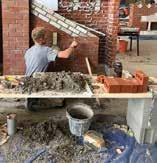

have sustained it for centuries.
As school counsellors, guiding students toward a future where they can thrive is a critical responsibility. In a trade like masonry, the opportunity to pass down knowledge and craftsmanship is both a duty and a privilege. The Manitoba masonry industry is dedicated to ensuring that young masons are not only equipped with the skills they need, but also inspired to carry forward a proud tradition of building strong, beautiful, and lasting structures.
Encouraging students to explore careers in masonry means opening the door to a future where they can contribute to their communities in meaningful ways while finding personal and professional fulfillment. l
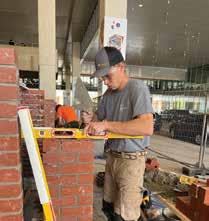

At the MMCA, our mission is to assist today’s youth in discovering a
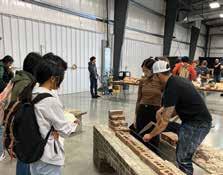
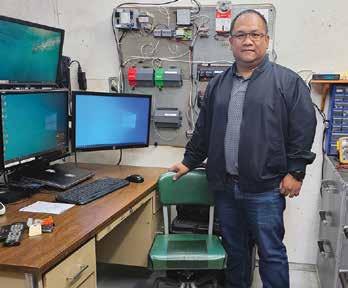

The Certified Technicians and Technologists Association of Manitoba (CTTAM) is the regulatory body for engineering and applied science technicians and technologists in Manitoba.
As a member of Technology Accreditation Canada, we provide high-quality professional development and extensive guidance to over 2,400 members and advocate for our profession across the country.
We work closely with educational institutions to accredit technology programs in disciplines that include architecture, civil, electrical, and electronics. In partnership with RRC Polytech, we currently have nine accredited technology programs at the Certified Engineering Technologist (C.E.T.) level. RRC Polytech graduates qualify for the C.E.T. designation after also completing two years of relative work experience.
Frequently, employers require applicants to be certified as a C.E.T. Our regulated titles C.E.T. (certified technologist) and C. Tech. (certified technician) are recognized across the Canada with the ability to transfer and retain certification in other provinces.
We advance our profession and aid our registrants through targeted courses, assorted benefits, and special registrant events. Our 11-member board is headed by President Josee Remillard with PresidentElect, Shannon Nordal, set to lead with a two-year term this fall. Registrants not only serve on our board but also on our numerous committees. Registrants frequently volunteer at several industry events that promote our organization and profession.
Check out our registrant initiatives, scholarships, mentor/volunteer opportunities, our advocacy programs, and how to become a member at www. cttam.com. Follow us on X, Facebook, and Instagram. l




trucking industry is looking for its next generation of leaders, and the search starts with you
With thousands of anticipated job openings over the next five years, now is the time to consider a career in the trucking industry. Whether it’s a driving career, being hands-on in the shop, or working in the office, there’s a role for you through all stages of your working life.
If the idea of getting behind the wheel and hitting the open road sounds appealing, a driving career might be for you. There are a variety of options, including long-haul, shorthaul, and local drivers. Long-haul drivers are typically on the road for a week or two at a time, whereas local pickup and delivery drivers are usually home every day. Drivers can work independently while learning new skills and meeting new challenges every day.
If you enjoy being hands on and fixing things, then a career as a truck and transport mechanic, transport trailer technician, auto body repairer or painter, or welder might be in your future. These careers are in high demand throughout Manitoba and across Canada right now. With the advent of new technologies, repair techniques, and an evolving range of tools, there’s never been a more exciting time to get into equipment repair and maintenance.
As part of the operations team at a trucking company, you’ll be responsible for making sure that your company is a success. You’ll manage, organize, and coordinate
every facet of the business and make sure that everything is operating smoothly. Careers in operations include dispatcher, safety, and claims, among others. However, there are also roles for those interested in finance (accounting, payroll, rate clerk), human resources, information technology, sales, customer service, occupational health and safety, and marketing.
According to Aaron Dolyniuk, executive director of the Manitoba Trucking Association, the opportunities in the industry are endless.
“So many of long-time industry members started out in the wash bay or sweeping the shop as teenagers, and from there, they built their







Trucking is an industry where you can be your own boss, grow and advance your career, and explore the world. There’s a role that will fit you now and grow with you in the future, so find your opportunity in Manitoba’s trucking industry.
entire career,” Dolyniuk said. “Some started their own companies, and some became presidents or CEOs. Some started driving and loved it so much that they spent their entire career as professional drivers. That’s the great thing about trucking: the sky is the limit when it comes to your career path. Some people want to try out different roles at different companies; others find their passion right away and stick with it.”
Danielle Tyszuk, outreach coordinator with the Manitoba Trucking Association, suggests that students keep an open mind and explore careers outside of their comfort zone.
“The best opportunities may lie off the career path that you think you’re heading down. Try new things to see if they interest you. Check out opportunities to explore the industry through internships, co-op placements,
summer jobs, and other opportunities,” Tyszuk said. “The trucking industry isn’t always the first one that people think of when choosing a career, but it’s an industry that can provide you with opportunities for your entire working life.”
Trucking is an industry where you can be your own boss, grow and advance your career, and explore the world. There’s a role that will fit you now and grow with you in the future, so find your opportunity in Manitoba’s trucking industry. Make sure to save the date for the Manitoba Trucking and Career Expo on Saturday, May 31, 2025 to learn more about Manitoba’s trucking industry.
Still have questions about a career in Manitoba’s trucking industry? Contact Danielle at the Manitoba Trucking Association by calling 204-632-6600. l



The Access Program at the University of Manitoba was created for students who have traditionally faced barriers to post-secondary education. For 50 years, the program has supported hundreds of students to achieve degrees in sciences, health sciences, liberal arts and fine arts. These students have built careers as doctors, dentists, nurses, pharmacists, respiratory therapists, occupational therapists, physical therapists, teachers, social workers and lawyers. Their contributions to the greater good within Manitoba’s communities are commendable and the Access Program professionals, as well as the entire University of Manitoba community, couldn’t be prouder of these valuable members of our society.
The Access Program accepts applications from all students and priority of acceptance is given to Indigenous, residents from northern and remote communities,
newcomers and financially compromised students. Students must be fully qualified for admission to the University of Manitoba.
The Access team is committed to creating pathways for student success. It is composed of academics, wellness counsellors and support staff specializing in areas such as student advising and financial literacy. This committed team of professionals has successfully created an atmosphere conducive to student development by approaching learning from a wholistic perspective, respecting the diversity inherent in Access’s community of learners. Over 90 per cent of the learners are Indigenous therefore Indigenous ways of knowing and being are woven throughout the program. The wellbeing of all students is of primary importance and respect is given to maintain the integrity of everyone’s individual identity, culture and tradition.








Becoming an Access student means that Access focuses upon creating a pathway to your academic success from day one to acceptance of your degree of choice. In your first year, you will become well acquainted with fellow Access students by registering in a common first year of courses that have been carefully selected as a cohort and taught by Access academics skilled in various academic disciplines. This common first year builds a strong learning community that gives students a solid foundation and sets the stage for academic success moving forward.
Submit your application to join the Access program by May 1 each year and begin your educational journey at the University of Manitoba with our support.

Many people are unaware of the exciting and diverse career opportunities in the lumber and building materials industry. No matter what your interests or skill set, there is a career for you in the building supply industry. Discover your future today!
Building supplies are an $80-plus billiondollar industry that allows you to grow no matter where you start. The timing has never been better to explore a new career. Based on a Labour Survey that the Western Retail Lumber Association (WRLA) conducted in 2023, 19 per cent of the existing workforce in the building supply industry will be retiring over the next five years, including a significant amount of leadership positions. Career paths that start from entry-level to becoming one of the company’s leaders happen more than one would think.
This industry is essential to the construction of homes, commercial buildings, and infrastructure projects worldwide. Everything that goes into building a home has a dedicated manufacturer who is looking for workers. Getting those products to the building site requires distributors, drivers, warehouse and yard associates, and retail store employees. These diverse companies need office talent, too! Accounting, marketing, graphic design, and front-line sales are all vastly different roles, but they all lead to a satisfying, lasting career.
As urbanization and the push for sustainable building practices continue
to start
This industry is essential to the construction of homes, commercial buildings, and infrastructure projects worldwide. Everything that goes into building a home has a dedicated manufacturer who is looking for workers.
to grow, so too does the demand for skilled professionals in this sector. For someone looking to start a career, this means job security and growth potential, making it an excellent field for those looking for a long and stable career. Explore opportunity paths in administration, skilled trades, sales, manufacturing, retail, and more!
For youth, newcomers to Canada, women, Indigenous groups, and anyone interested in a stable career, the lumber and building supplies
industry is the one for you. As students plan their next steps in their careers, WRLA offers multiple pathways to success and hundreds of opportunities.
WRLA has several free initiatives to help connect students with career resources. Internship programs provide hands-on experience. There is also a Job Board on www. wrla.org, which is a live listing of open positions across Canada with companies that are looking to hire now. Professionals from the WRLA
and their member businesses are available to connect directly with your schools to outline our career pathway programs and exciting curriculum opportunities to give students real-world training that can be the first step towards lifelong, rewarding employment.
Housing is on everyone’s mind these days, and many indicators show that there will be a lot of building starting over the next few years.
Those buildings will need supplies, and those suppliers need you! l
Wherever a student’s passions lie, there are opportunities waiting for the m.
Connect with the WRLA today and access our incredible resources:
1. View our job board, listing a wide range of positions across Canada
2. Follow us on social media for career development resources and information
3. Book time with the WRLA team and our members to present the many career and curriculum possibilities in the Building Supply industry to your school!

As business continues to change, students pursuing a career in Human Resources (HR) can help shape the future of work and make a difference for organizations and their employees.
Today, HR represents a dynamic career that could lead in many directions, but ultimately plays a significant role in helping businesses thrive and ensuring that employees feel safe, valued, and successful. Whether your students are drawn to recruitment, employee development, or strategic planning, HR offers a wide range of possibilities.
HR professionals are responsible for creating an environment where employees understand how their role contributes to the greater purpose and success
of the organization. They develop strategies to keep staff motivated, engaged, and committed to their work, fostering a sense of belonging and pride.
People in HR help define and advance company culture. They ensure that employees are learning, growing, excelling, and enjoying their work. They help create a positive work environment by developing policies and programs that promote a strong sense of community.
They are also responsible for helping people thrive individually. HR professionals protect the mental and physical health and safety of employees. They create and deliver programs and policies around topics like job safety, mental health, wellness, harassment, violence, discrimination, diversity, equity, and inclusion.
Launch a dynamic career in HR.
HR professionals are strategic thinkers and advisors who help businesses embrace new technology, shifts in the market, and innovative ways of working. A career in Human Resources encourages professional growth in a field dedicated to helping people and businesses thrive.

Learn more at CPHRMB.CA

Business leaders are increasingly turning to HR professionals for guidance and strategic advice. They depend on HR professionals for help with strategic planning, professional and ethical practice, critical problem-solving, analytical decision-making, change management, workplace culture transformation, conflict resolution, and relationship management.
HR professionals are responsible for recruiting and retaining the right people for the job by setting salaries, defining benefits and perks, managing and conducting performance evaluations, and resolving workplace problems and concerns.
They help companies and employees find fair resolutions to contract and legal issues and are responsible for ensuring that companies are following human resources laws, union rules, and contract obligations.
For students interested in leadership roles, HR can evolve into senior and executive positions. Leaders in HR work at the highest level of the organization to help set company priorities, lead teams, and ensure HR policies and activities are working on behalf of the organization and the staff.
HR professionals help prepare the workforce for change
and empower people to embrace new directions. They use analytics and technology to make evidence-based decisions and drive innovation. HR professionals navigate cultural differences and help diverse teams work together harmoniously.
At the forefront of shaping the future of business, HR professionals ensure organizations value both profit and people, adapting to new technology, responding to shifts in the market, and embracing new ways of working.
Students in HR can become a Chartered Professional in Human Resources (CPHR), a national designation, similar to an accountant who can become a CPA.
The CPHR designation represents a commitment to a national standard of excellence and a dedication to upholding the gold standard in the field. It can open doors to leadership positions and increase the average HR professional’s earning potential by $20,000.
The role of Human Resources is becoming more critical to Canadian organizations every day. If your students are interested in pursuing a career dedicated to helping people and businesses thrive, encourage them to consider a career in HR.
Visit www.cphrmb.ca to learn more.l

MITT has seen an influx of students choose its programs right out of high school. More and more students are selecting colleges in Manitoba as their first choice for post-secondary education.
MITT is a public college offering more than 30 one- and two-year programs in applied business, design and manufacturing technologies, health care, human services, information and communication technology, and skilled trades.
What makes MITT unique is that it integrates career training and professional skills into every program at the college. Students learn things like communication, adaptability, problem-solving, professionalism, and collaboration, which are critical for any industry and transferable from role to role.
“We are giving students the chance to gain valuable experience and the technical and professional skills needed to start a career,” said Celia Vielfaure, manager of career and

employment services at MITT. “With hands-on education and integrated guidance from MITT’s Career and Employment Services team, students can enter the workforce with confidence.”
The Career and Employment Services team ensures students receive career exploration and advice through multiple avenues. They provide one-on-one career counselling services to students, prospective students, and alumni seeking specific career advice. They also introduce students to their industry of interest through in-person interactions with people in their field.
The Career and Employment Services team connects students with industry in various ways. This includes guest speakers, panels, career fairs, and much more.
Employers meet with students and share what is important in their industry or specific business. The career exploration that happens through learning job-specific duties, success skills, and career
opportunities proves beneficial to students with a variety of end goals.
Many of MITT’s programs offer skills that are transferable in the future. MITT’s Medical Office Assistant, Business Administrative Assistant, and even Culinary Arts and Design are programs that provide students with great lifelong skills. We have seen students take our CAD program and move on to some of our trades programs or to other institutions for programs in architecture or construction management.
There is no better way to learn than by doing, and that’s true of both job skills and career exploration. MITT ensures students get the experience they need to be set up for success. The professional skills students gain make them desirable employees and are transferrable wherever their career goals take them.
For more information about MITT, its programs, and career supports, email recruitment@mitt.ca or visit www.MITT.ca. l

The University of Winnipeg provides an environment where students can discover new passions and pursue their dreams, and through unique opportunities and oneto-one interaction with faculty, UWinnipeg students are given the opportunity to make meaningful change locally and globally.
An enthusiasm for science was the earliest building block for Hailey Langford. Arriving at UWinnipeg, she was fascinated by disease treatment and the pursuit of new and innovative solutions. It was through these interests she was first introduced to Biology professor Dr. Anuraag Shrivastav, who opened her eyes to “new opportunities in science and cancer research.”
In short order, Langford began volunteering as an undergraduate student in labs alongside Dr. Shrivastav, learning lab techniques and research methods en route to her degree in biochemistry. The bond formed with Dr. Shrivastav and his collaborator, Dr. Harminder Singh, forged a path for Langford to join in their research in a paid post-undergraduate position.
Alongside her mentors, she’s working on a new blood test
to assist in the early, accurate, and cost-effective detection of colorectal cancer.
“We hope this less invasive blood test will help detect colorectal cancer in patients early and improve treatments and quality of life for the patients and their families,” said Langford.
While Langford assists in the pursuit of medical breakthroughs, students such as Carson Ouellette are searching for ways to make an impact on the next generation.
An Education student, Ouellette was selected as one of eight undergraduate students to represent UWinnipeg at the Western Canadian Student Teacher Conference (WestCAST). Students were given the opportunity to present independent inquiry projects at the conference, covering a range of issues relevant to contemporary educators, including supports for youth from diverse backgrounds, education aligning with the Truth and Reconciliation 94 Calls to Action, and increasing teaching professionals in rural areas.
For Ouellette, the opportunity to attend and participate at the conference was meaningful.
“Personally, presenting at WestCAST is a valuable practice in public speaking, a skill paramount for educators,” he said. “Professionally, my research has compounded my interest in education, specifically in rural areas.”
As Ouellette thinks local, however, UWinnipeg is also opening doors for its students to go global.
In his first year, Thomas Hepworth attended a UWinnipeg workshop on scholarship opportunities, where the opportunity to receive a summer student fellowship from the Institute of Particle Physics (IPP) caught his eye.
Earning the fellowship served as motivation throughout his studies and, two years later, Hepworth spent this past summer in Switzerland working alongside some of the world’s top physicists at CERN, the European Organization for Nuclear Research. The IPP fellowship also comes on the heels of three trips to TRIUMF, Canada’s particle accelerator centre in Vancouver.

Hepworth is thankful he’s been not only allowed but encouraged to pursue these experiences as an undergraduate student, which might not be the case at every post-secondary institution.
“UWinnipeg definitely leverages that well for its students,” he said.
Learn more about how The University of Winnipeg helps students learn, grow, and achieve academic and career success at www.uwinnipeg.ca. l

The University of Winnipeg is where students discover their full potential:
› More interaction with professors
› A diverse and friendly community
› World-class research and learning opportunities uwinnipeg.ca
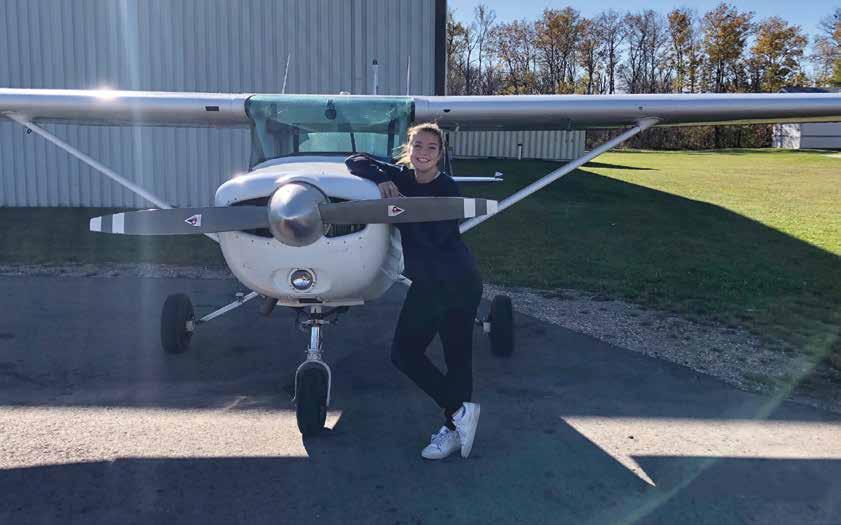
With more than 300 sunny days a year, Manitoba is an ideal place to learn to fly. Providence University College, in partnership with Harv’s Air, is uniquely situated in southern Manitoba to offer a one-of-a-kind, quality aviation education.
As one of the few Christian universities in Canada to offer a Bachelor of Arts (BA) in Aviation, Providence provides a well-rounded education that airlines are looking for, all the while integrating your faith into your studies. You will do your flight theory and training at Harv’s Air (Steinbach) and take undergraduate-level courses on our Providence campus (Otterburne).
“I love the aviation program at Providence. It is very unique in that you can attain a degree while completing different licenses and ratings,” said recent grad Kate Hanson.

Our aviation degree options include:
• BA 4-Year Advanced Major
• BA 4-Year Double Major
• BA 3-Year Major
• 2-Year Diploma
• Minor
Some of our students combine the Aviation major with another university program such as Intercultural Studies or Business Administration for a double major.
Before your first semester starts, Providence holds a week-long aviation camp where you’ll gain basic ground training and actual flight experience before regular classes even begin. This will prepare you to achieve your PSTAR certification (a student pilot’s license) so that flight training can begin on day one of classes.
In your second year, you’ll embark on a week-long, cross-country trip. In previous years, students have flown to San Diego and back via the Grand Canyon. With as many as seven planes flying in formation, you’ll gain valuable experience and rack up those required flight hours.
Thanks to an in-classroom simulator and wide range of airplanes at Harv’s Air, you’ll fly a variety of single-engine and multi-engine planes while logging valuable instrument training hours. Currently, Providence is working on collaborations with major airlines to help meet the critical pilot shortage and provide various employment opportunities for our aviation graduates. We are now offering the Airline Transport Pilot License (ATPL), which is the highest license one can earn as a civil airplane pilot. This allows one to be the captain or pilot in command of a multi-crew airplane.
Whether you want to be a flight instructor or a private, commercial, military, or Medevac pilot, you can gain hands-on training and grow your knowledge in a supportive learning community at Providence University College.
“The people that make up the Providence community are unlike any I’ve met before,” explained Kate, who completed her three-year Bachelor of Arts as an aviation student. “It is such a welcoming and accepting place that makes you feel right at home.” l

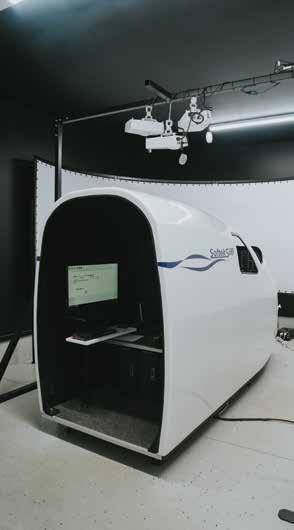

BY DR. JOHN BRUBACHER, ASSOCIATE PROFESSOR OF BIOLOGY
Near the end of a research leave that I spent at the University of Wisconsin-Madison, I had the opportunity to train as a partner instructor in the Tiny Earth program that’s headquartered there. This program, launched in 2018, is a microbiology lab curriculum being pursued by a growing international network of students and instructors. The program’s goal is to “studentsource” the discovery of new antibiotics – one avenue of response to the emerging crisis of antibiotic resistance in diseasecausing bacteria. Tiny Earth is the brainchild of one of my scientific and pedagogical heroes: Jo Handelsman, a soil microbiologist and director of the Wisconsin Institute for Discovery at UW Madison.
The 17 students in my Microbiology I course in winter of 2023 worked with me to integrate Tiny Earth into the lab curriculum for that course. The basic idea is straightforward: students isolate pure strains of bacteria from a soil sample. We used about a quarter teaspoon of humus from the woods just south of the Director of Student Life’s residence on the CMU campus. Each student assembles a library of about 20 strains of
soil bacteria and screens these strains for antibiotic production by growing them on lawns of “tester strain” bacteria. The tester strains are non-pathogenic relatives of species that have been identified by the World Health Organization as pathogens of critical concern. From these screening experiments, students identify soil isolates that inhibit the growth of one or more tester strains: those isolates are producing something that is acting as an antibiotic.
Over the semester, the students learn the microbiological skills and techniques that are standard for an introductory microbiology course. But they learn in the context of doing real science, asking questions that no one knows the answer to, and seeing where their observations lead them. Students are engaged and empowered by participating as scientists in a project of genuine public interest. Studies of such course-based undergraduate research experiences routinely demonstrate the benefits of this discovery-based approach.
The 2023 iteration of Microbiology I, plus three biology

students who continued the project in independent study courses this past fall, have so far identified nine strains of interest from local soil. The likelihood of any of these nine being the source of a new antibiotic is quite low, but the growth of the Tiny Earth network around the world greatly increases the odds of discovering something useful. Along the way, students may also gain a new appreciation for some timeless theological lessons, about the beauty and complexity of small things, and of the need to use the gifts of the soil reverently and wisely.
This project is just one example of the research in which CMU students can participate in and contribute to.
Working on projects with faculty, conducting literature reviews, data analysis, presentations, and hands-on lab work give students the fundamental skills and understanding of the modes of operation to conduct scientific research.
For more information and updates on Tiny Earth, see www.tinyearth.wisc.edu. l


Question: Can you briefly tell us why a Grade 12 student should consider Booth University College for their post-secondary education?
PresidentFringer: First is because of our mission and purpose, which is embodied in the phrase “Education for a Better World.” We believe education is transformative, both for the individual and for society. Our core values of hope, mercy, and social justice guide all that we do at Booth UC and our graduates are making a positive impact in the communities in which they live and work. Second is our small class sizes. At Booth UC, you are not just a number lost in the crowd. Our average class size is 14 and we have a student to faculty ratio of about 11:1. At Booth UC, professors know each student by name and the small class size provides space for students to engage the subject in a robust way and to ask questions and seek clarifications. Third is that
all our programs include elements of experiential learning (or learning by doing). From field placements to internships and Urban Service Learning, our students get hands-on experience that help them connect theories and knowledge learned in the classroom to real-world situations and helps them embody the mission of Booth UC.
Q: Okay, Dr. President, let me interrupt you for a second and ask a quick follow-up question to your third point. How do you manage to have partner agencies that can accommodate all your students for their hands-on, experiential practicum component?
PresidentFringer: As you may know, Booth University College was established by The Salvation Army (TSA), which thankfully runs the largest social services agencies outside of the government in Canada (and in many other world areas). Although there is a delineation and separation of powers in terms of the overall running of Booth UC from TSA, our connection gives us an advantage that many other schools do not have. Just in our Bachelor of Social Work (BSW) degree only, which requires two field placements over the four-year program, we have active partnerships with around 140 agencies in Manitoba who gladly take Booth UC students for field placements. And once our
Social Work students graduate, they find it easier to secure jobs in their profession.
Q: Would you say this has positioned your university to give back to the community or, to use your words, to provide “Education for a Better World”?
PresidentFringer: Absolutely! It will interest you to know that, on average, our students contribute between 34,000 to 38,000 hours of volunteer service every year to the community through field placements in the various social service agencies. This would still be impressive if we were talking about a school with thousands of students, but Booth UC has an average student body of around 400plus students. This is a reminder that a small group of people can make a big difference!
Q: You haven’t told us anything about your fees. How competitive are you?
PresidentFringer: I am glad to inform you that despite receiving very little public funding compared to other post-secondary institutions, our domestic tuition ranks quite low among private institutions in Canada and our international fees are among the lowest across Canada’s institutions, both private and public. Additionally, Booth UC provides between $150,000 to $175,000 in scholarships and needsbased bursaries each year. I have to
















to explore all our programs
Psychology
- Mikayla Conci (BBA/22)
Financial Assistant, Government of Manitoba
- Community Mental Health
Behavioural Sciences
Religion
Business Administration
Interdisciplinary Studies
English & Film Studies
Community and Urban Transformation
Social Work
say, it still amazes me that a small university college operating on a small budget can be so generous and offer rigorous academic programs that engage the mind, challenge the norms, empower students, and enrich the world.
Q: Many students start post-secondary education and shortly after end up dropping out of school. Is this something that Booth University College also struggles with?
PresidentFringer: Every postsecondary institution experiences
some attrition, for a variety of different reasons. At Booth UC, we have all worked hard to provide the kinds of supports that help students stay connected, engaged, and have led to greater success in completing their degrees. Our Students Services Department and Faculty work closely and compassionately with each student based on their situation and needs, and I am positive that this is what accounts for our high retention rate – an average of 83 per cent over the past five years!
Q: Thank you, President Fringer. Any final word?
PresidentFringer: I invite all Grade 12 high school students to visit our website (www.boothuc.ca) and check out our various programs. I also encourage you to fill out the application; it is currently free for all domestic students. When your application is completed, one of our Admissions Counselors will contact you and provide you with all the information you need to make an informed decision about whether Booth UC is the right place for you. l
BY JOCELYNE LALONDE, MSC, PHEC
In the ever-evolving landscape of education, schools are increasingly recognizing the profound impact of trauma on students’ lives. This blog explores the significance of trauma-informed schools, shedding light on their transformative power in fostering a supportive and healing educational journey.
Trauma comes in various forms, ranging from personal experiences like abuse and neglect to broader societal challenges such as community violence, natural disasters, and intergenerational trauma. For many students, the effects of trauma extend far beyond the immediate event, influencing their emotional well-being, behaviour, and ability to learn. Trauma-informed schools recognize the widespread prevalence of trauma and aim to create spaces where students and staff feel understood, validated, and safe.
When students feel emotionally and physically safe, their
cognitive abilities can flourish. Trauma-informed schools see improvements in academic performance because of reduced stress and increased ability to focus.
Trauma-informed schools witness a decline in behavioural issues because they prioritize understanding and addressing the root causes of behaviour, creating safe and supportive environments that fosters positive relationships.
A positive school culture is one where empathy and understanding are central values. This not only benefits students but also creates a more supportive and fulfilling work environment for educators.
By addressing trauma and providing support, traumainformed schools contribute to the development of resilience in students. The skills and coping mechanisms learned in a trauma-informed environment can have

lasting effects on individuals’ ability to navigate challenges in the future.
Adopting the principles of trauma-informed schools and taking gradual steps to implement practical strategies is the best approach. Here are five principles and strategies for building trauma-informed schools:
1. Shift attitudes
This involves cultivating a mindset of empathy, understanding, and nonjudgemental support among educators, staff, and students. Shifting attitudes helps foster a culture that recognizes and responds to the impact of trauma with sensitivity and compassion.
2. Promote awareness
Trauma-informed awareness is not limited to specific individuals or departments – it permeates the entire school community. From administrators to custodial staff, everyone plays a role in creating a trauma-informed environment.
3. Foster safety
Trauma-informed schools prioritize physical and emotional safety. This involves creating a secure physical environment while also fostering a culture of respect and trust among students and staff. Establishing routines and
clear expectations contributes to a sense of predictability, which can be especially comforting for those who have experienced trauma.
4. Provide empowerment and choice
Trauma can leave individuals feeling a loss of control. Trauma-informed schools aim to empower students by providing choices within the learning environment. This can range from allowing students to choose projects or activities to offering alternative methods of expressing understanding.
5. Highlight strengths
Acknowledge and celebrate the positive qualities, talents, and resilience of both students and staff. This principle encourages a focus on individuals’ capabilities rather than solely on challenges. For instance, a teacher might regularly incorporate moments of recognition for students’ unique skills or accomplishments during class, promoting a positive and affirming atmosphere.
Trauma-informed schools represent a paradigm shift in education, acknowledging the diverse experiences students and staff bring into the classroom and adapting to meet their unique needs. By promoting awareness of trauma and fostering safety, empowerment, and choice, as well as highlighting the strengths of the entire school community, you create an environment where students can not only learn but also heal. l

At Pembina Trails School Division, a vital component of our efforts to provide a safe and inclusive learning environment for our students and staff is our firm belief in equity, diversity, inclusion, and anti-racism.
Some highlights of the many ways we make anti-racism a priority:
• We developed our anti-racism policy through extensive community engagement and consultation.
• The focus is on policy that is responsive, meaningful, and a living document.
• As part of the Division’s antiracism regulation, Pembina Trails is committed to workplace diversity by cultivating growth, allyship, and anti-racism advocacy while enhancing hiring and empowerment of IBPOC staff. This includes training for leaders in the area of hiring bias and statements of commitment on our hiring site which actively encourage applications from members of equity-deserving groups with diverse abilities, backgrounds, cultures, and identities.
• Members of our leadership community participated in a conference last October, led by Rebecca Chartrand from Indigenous Strategy Alliance. The theme of the conference was “Diversity, Equity and Inclusion.”
• Seven of our schools participated in UNESCO’s Associated Schools


Project Network. The theme was “The Stories of Place and the Place of Stories.” Students collaborated throughout the year and researched the history of the land where their school currently resides.
• Many of our teachers and administrators participated in “Words Matter” or “Speak Up at School” workshops, where they were equipped with language and materials to help build capacity in their buildings when responding to incidents of harm. Using these resources, educators and students developed the skills to interrupt, question, and respond appropriately when they heard language that was hurtful.
• Our Curriculum and Learning Services department piloted the first “Inclusive and Responsive Classrooms” program. This program worked with teachers from two schools to explore and develop culturally sustaining
curricula, assessments, and classroom environments.
• Over 40 of our teachers came together for a three-part series on anti-racism. The series highlighted themes of positionality, power, history, and strategies for responding to racism in schools.
• We created a steering committee for 2SLGBTQIA+ inclusion in our schools. This committee worked throughout the year to gather resources, network with organizations like Egale Canada, and distribute information to school leaders and teachers to help students understand diversity and promote acceptance and belonging in their schools.
• All staff will receive Treaty Education on Friday, November 29, 2024. This aligns with Treaty Education for All, mandated by Manitoba Education and Early Childhood Learning, as part of Manitoba’s response to the Truth and Reconciliation
Commission’s Calls to Action and is consistent with the objectives of the Manitoba’s The Path to Reconciliation Act.
The best way to convey the importance we place on our antiracism efforts comes from our Statement of Commitment: “Pembina Trails School Division firmly believes that every student has the potential to achieve great things, regardless of their race or ethnicity. Through ongoing education and engagement with students, parents/caregivers, and colleagues, we will work to promote anti-racism and social justice in our school communities. We will actively listen to the voices and experiences of students and staff from diverse backgrounds and strive to create a curriculum and learning environment that reflects and celebrates diversity. We are committed to creating safe and inclusive spaces for all students and staff, and to continuously learn and grow together.” l
Engineers Geoscientists Manitoba has long been aware of the underrepresentation of Indigenous engineers and geoscientists. Because of this, EngGeoMB has implemented strategic measures and initiatives to promote the professions to Indigenous students and make visible the resources and career paths available to them.
In 2023, EngGeoMB completed an environmental scan on Indigenous barriers to Indigenous participation in the professions. Among the reasons discovered were the lack of social, financial, and educational supports for Indigenous youth, which make pursuing an education in the professions nearly impossible. Focus groups revealed that most didn’t

know anyone who had practiced in the field and did not see themselves represented in images of engineers and geoscientists online.
To make Indigenous engineers more visible to everyone, especially to Indigenous students and parents, EngGeoMB developed the Our Future campaign, which highlights five Indigenous engineering students, interns, and professionals studying and practicing in areas of renewable energy and infrastructure to present Indigenous youth with what a future in engineering could look like for them. Indigenous worldviews, such as being stewards of the sacred lands on which we all reside, combined with the concepts inherent in engineering and geoscience, are vital in areas such as solving for clean energy solutions, clean water, safe transportation, efficient vehicles, communications infrastructure, along with other problems that require STEM (science, technology, engineering, and math) principles.
Visible representation of successful Indigenous professionals who are from their own communities, who are using their STEM skills to directly problem solve environmental, social, and technological issues, can inspire Indigenous students to explore engineering and geoscience as career options.
Nationally recognized programs
designed to support Indigenous youth to pursue an education in the professions are also critical for success. The Engineering Access Program (ENGAP) at the University of Manitoba offers any Indigenous student applying to the Price Faculty of Engineering academic, financial, social, and personal supports to succeed in their studies. Academic support at ENGAP includes offering the pre-requisites for first year, which are frequently not available in remote communities, as well as upgrading and tutoring to ensure that students are prepared and supported. ENGAP is repeatedly cited by its graduates as being instrumental in their success, some of whom had been told as high school students that they would never go to university.
There are also programs designed for K to 12 students. The Verna J. Kirkness Educational Foundation (VJKF) has partnered with universities across Canada (including the University of Manitoba) to offer scholarships to Indigenous students in grades 11 and 12 in order to spend a week on a campus in the summer with other students from across the country.
These scholarships provide Indigenous youth with a structured opportunity to travel to a university, learn about campus life, stay in a dorm, eat in the cafeterias, work alongside engineers and scientists in research laboratories, conduct experiments and analysis, and participate in programmed social events organized by counsellors. They are also encouraged to ask guiding questions about how to further pursue a STEM career path if interested.
run in July and August. This program is completely free for Indigenous youth (including snacks and meals) and is aimed at grades one to eight. Youth involved in these camps get to experience activities that include science, technology, engineering, arts, and math concepts. Activities in the program include introductory coding, rocket building and launching, 3D design and printing, materials design and testing, and other STEM activities.
Engineers Geoscientists Manitoba has been invited to participate in some of the sessions over the years, conducting activities with Indigenous youth that include building newspaper bridges to teach the concepts of sustainability and stability. The students then get to test how much of a load their bridges can support. Activities have also

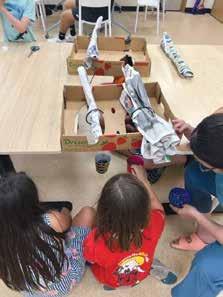
included building small boats to go into water out of newspaper that must also support a load without sinking to introduce the concept of buoyancy.
We would encourage guidance counsellors and teachers to share these resources with students and caregivers so that they may take full advantage of these opportunities. l


Another example of Indigenous STEM programming is the Wii ChiiWaakanak summer camps on the University of Winnipeg campus that



As educational institutions increasingly strive to meet the diverse needs of students and communities, the inclusion of antiracist approaches has become imperative in Louis Riel School Division (LRSD). When promoting anti-racist education in schools, LRSD educators are keenly aware of legacies of colonialism, imperialism, and systemic barriers that continue to impact the education system. LRSD grounds its commitment to anti-racism by embedding diversity, equity, inclusion, and anti-racism (DEIA) pedagogy, practice, and purpose into its carefully crafted Multi-Year Strategic Plan (MYSP). The plan prioritizes both accessibility and a sense of belonging for students, staff, and community members as well as establishing a
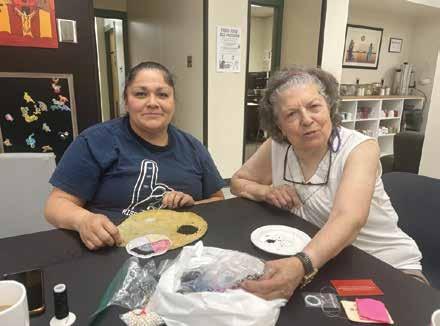
holistic model of learning, centering students as the authors of their own stories.
Collaboration among staff, students, and community is an integral component of the MYSP. Divisional staff are continuing to engage in professional learning and approaches that are informed by the ethic of hospitality, underscoring the importance of relationality and recognition that each person has a unique story to tell. Divisional teams have placed a deliberate focus on these individual stories of students and community through collective learning around Street Data that creates opportunities to engage in authentic dialogue with all equity deserving groups in explicit ways. The commitment to learn about the unique and diverse cultures and
backgrounds of students has helped to create a sense of belonging among students. It is essential that students see and feel that their worlds are represented in the classroom and in the hallways of their schools to enhance their sense of belonging and safety within their school communities.
Professional learning for clinicians and members of the school and classroom support team has been integral for laying the foundation for anti-racism work that is grounded in explicit opportunities for selfreflection and learning alongside community and members of the divisional Council of Grandfathers and Grandmothers and Indigenous education team. Supporting the agency and autonomy of students and families is imperative to
fostering equitable relationships and providing the best support possible for all students in the education system. Building on trauma-informed models of support that are both culturally centered and strength based can help to strengthen these relationships. Recently, school social workers and Indigenous knowledge keepers have committed to working alongside one another to lead Buffalo Riders in schools.
Buffalo Riders was developed by the Thunderbird Partnership Foundation. It is an evidence-based mental wellness model that is developed and modeled after Indigenous ways
of knowing and being, through the development of positive self-esteem in youth, pride in community, and the skills to recognize and resist social pressure in order to promote Mino-Pimatisiwin – The Good Life. This is just one example of the ways school teams are working together to ensure the representation of voices in student, staff, and community learning.
LRSD is working to prioritize relationship building to bridge the gap between communities and systems. Following the lead of the Truth and Reconciliation Commission Calls to Action, the
LRSD is dedicated to moving forward in a way that critically examines the role of the education system on the path to healing among First Nations, Metis, and Inuit peoples, while also ensuring students of all backgrounds are valued, supported, and respected for who they are. By planning with, rather than for, community and embracing humility, school teams in LRSD are working to challenge the colonial legacy of the education system and celebrating the diverse ways of knowing that strengthen our learning communities.

“I don’t think I would be where I am today without the supports of the Access Program. Access is really good because it establishes a community within a larger whole.”
Brandon
Wosniak, UM student Métis living in Winnipeg
The Access Program includes two paths:
The University of Manitoba Access Program (UMAP) supports students in degree and diploma programs at UM. It is available to all Manitoba residents, with preference given to Indigenous people, residents of Northern Manitoba, low income earners, and newcomers.
The Health Careers Access Program (HCAP) supports Indigenous (Status, Non-Status, Métis, Inuit students) for entry to health-related professions such as Medicine, Dentistry, Dental Hygiene, Pharmacy, Rehabilitation Sciences, Nursing and Midwifery Program. Students must be residents of Manitoba.
Access students receive:
• Academic Advising
• Personal Counselling
• Full-time Indigenous
• Smaller Classes
• Learning Labs
• Tutoring Hours Included Unkan (Grandfather)
• Connection to the • Student Aid Advisor Indigenous Community
To learn more, visit umextended.ca/access or call 204-474-8000









